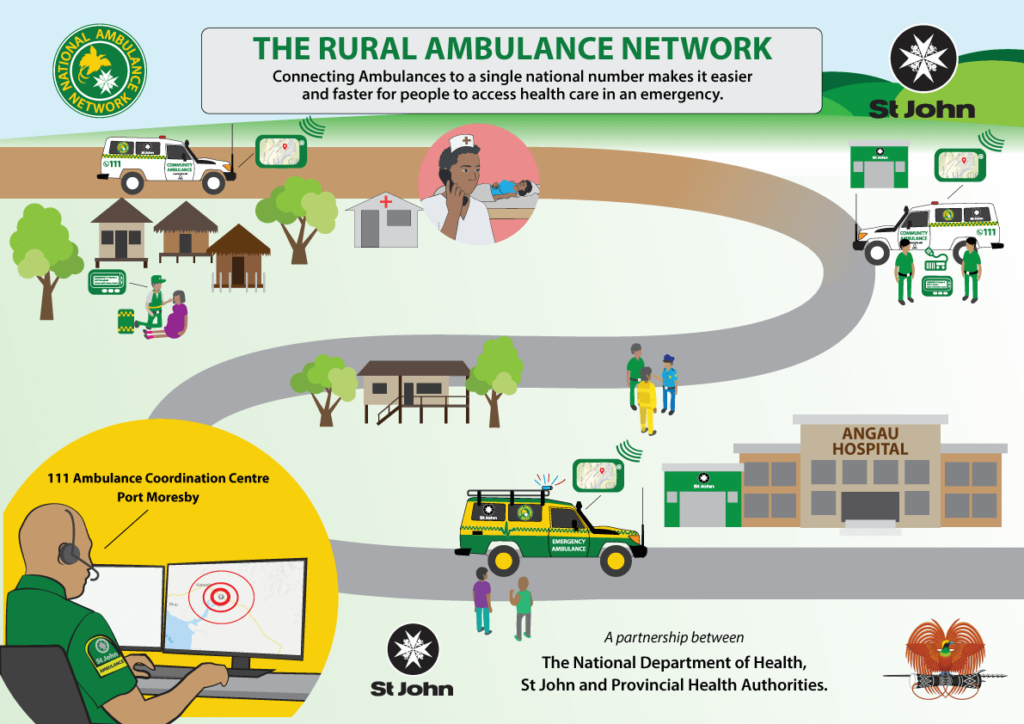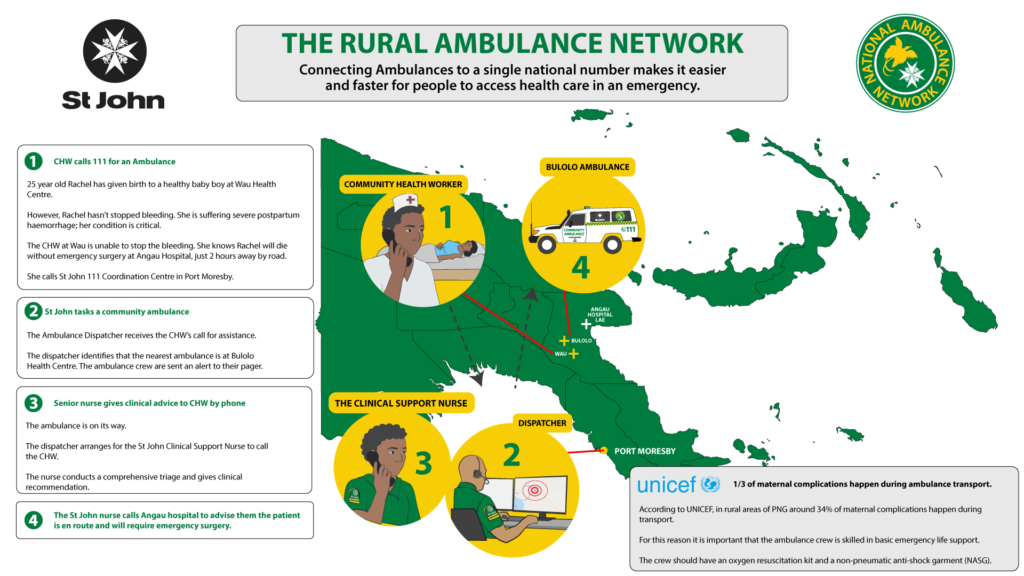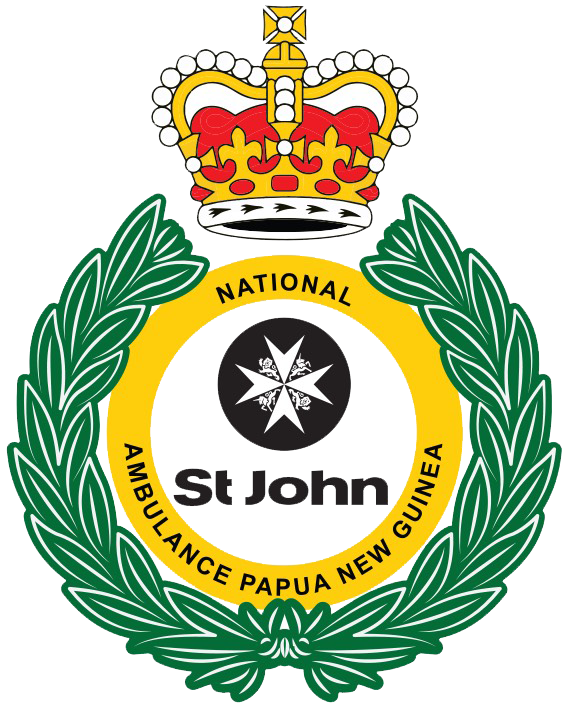
Connecting Ambulances Across PNG to One Network
St John has been tasked by the National Government to establish and manage the National Ambulance Network over the next decade.
St John is a humanitarian and health care royal charter organization that specializes in ambulance, prehospital and emergency health care. St John PNG is a statutory incorporation that has been operating in Papua New Guinea since 1957.
In 1983, St John began managing ambulance services for the National Government in Port Moresby and other capital cities.
In 2018, the National Government appointed St John to setup a National Ambulance Service (NAS) in Papua New Guinea over the next ten years.
The overarching aim of the National Ambulance Service is to promote health and wellbeing and prevent avoidable death and disability for the people of Papua New Guinea by providing pre-hospital care and coordinated emergency transport.
The NAS aims to:
- Make it easier for people to get help from an ambulance
- Provide reliable, safe and efficient ambulance services to urban and rural communities
- Operate an efficient inter-hospital retrieval and transfer service to enable escalation of care
- Train health workers in the provision of pre-hospital and emergency care
- Support health workers to provide consistent high-quality care through provision of clinical guidance, protocols and telemedicine advice.
The intention of the National Ambulance Service is that all government-funded ambulances will be networked to the St John 111 coordination centre in Port Moresby by 2030 – just like other ambulance services in the world.
The principle underpinning the NAS is that citizens in any location can call 111 and receive help from St John, whether by road, air or sea and in some cases individual tele-medicine advice.
The NAS will connect, equip and train existing district health center ambulances in partnership with the Provincial Health Authorities. Provincial ambulances will be connected to the 111-emergency network. This enables efficient and effective co-ordination of resources, without duplication. It also supports consistent delivery of high-quality clinical care between urban and remote locations by facilitating access to telemedicine advice from professional medical, nursing and paramedic staff.
The NAS aims will be achieved by:
- Connecting all rural and urban ambulances to one national ambulance network reachable by toll-free number: 111
- Operating professional ambulances in urban centres
- Training, equipping and coordinating
1.Community-level ambulance workers in health centres around the country
2.Hospital retrieval teams - Operating a retrieval network that retrieve the most urgent and severe cases from rural health centres to hospitals promptly and safely, including:
1.Operating ground ambulance for public and private patients
2.Operating funded air ambulances for public and private patients - Expanding knowledge of first aid in the community through:
1.Teaching emergency first aid to police and other emergency responders
2.Teaching basic first aid in schools and to grass-root communities
3.Making professional first aid training available to businesses and government bodies - Monitoring and evaluating ambulance performance and clinical case information
- Providing timely information to a wide range of stakeholders about the NAS and its activities.
The NAS intends to progressively roll-out in each province as part of an Agreement between the National Department of Health, the Provincial Health Authority (PHA) and St John. Provinces that have not yet established a PHA but wish to be included in the NAS will be required to sign a trilateral agreement between the National Department of Health and St John. The Agreement may include various models of ambulance service, including urban professional and rural community ambulances tailored to the Province’s specific needs.
Under the Agreement, St John will coordinate all ambulances from the National Ambulance Coordination Centre in Port Moresby. St John will be responsible for maintaining communication systems that ensure efficient receipt of calls and prompt dispatching of ambulances.
St John will also provide training and equipment to Provincial Health Authority and Regional Hospital health workers when asked, on a cost recovery basis.
We expect that a standardized and centrally coordinated approach to ambulances services will improve efficiency, reduce misuse and result in better quality prehospital emergency care.
Ambulances help improve access to health services, particularly for rural and urban disadvantaged communities for whom there are major barriers to accessing healthcare during emergencies.
Ambulances are shown to improve health care for rural populations
For many emergencies, appropriate management in the first hour can be a critical determinant of survival. Ambulance services are an integral component of an effective health system. Their particular contribution is early provision of treatment that is critical to supporting survival, while transporting patients to appropriate health services. The number of people dying from key health areas prioritized in the National Health Plan, as well as other causes of illness, could be reduced through improved ambulance and prehospital health care. Similarly, the pain and suffering caused could be reduced through improved ambulance and pre-hospital health care.
Currently, it is very difficult for people in rural areas and even many of our cities to obtain help from an ambulance. This is largely because there is no central number for people outside of Port Moresby to call. This is despite the significant need for health services in the community and the closure of up to a third of aid posts in rural areas.
Effective transport services have been able to increase the number of women attending health services for their births in low-income settings. This is important in preventing complications, and also enables rapid treatment of unpredictable obstetric emergencies (Sacks 2015). The addition of improved ambulance and communication networks contributed to a halving of maternal mortality in Ethiopia (Godefay 2016).
The Proposed Structure of the National Ambulance Service
St John will provide central coordination of all national 111 emergency calls and dispatch an ambulance service in response. There are three models of ambulance provision that St John can support through partnership with PHAs (refer to organizational chart p. XX).
- RURAL AMBULANCE – A Network of all District / PHA /health centre Ambulances in each province, delivered in partnership with district and provincial health services
- PROFESSIONAL AMBULANCE – Professional Emergency Ambulance in major urban centres operated by St John Ambulance
- REFERRAL NETWORK – co-ordination and support for ground and air retrieval services provided by Provincial or St John Ambulance health professionals.
Central Coordination: National Ambulance Network
All ambulance services, including professional ambulances, rural ambulances and the referral network will be managed through centralized coordination of the National Ambulance Network (NAN), based at the St John Headquarters in Port Moresby. The Ambulance Emergency Call Centre will receive all 111 calls from across the country. The St John NAN will determine the most suitable ambulance resource/s to attend a case depending on urgency, severity and complexity of the case. The nurse or senior officer within the NAN Coordination Centre will determine urgency, severity and complexity based on information from the caller and crew on scene.
The ambulance service dispatched will also vary depending on the local service model. It will be either an urban professional or rural community ambulance. Where available, this may include a retrieval team composed of provincial or St John ambulance professional ambulance staff.
All ambulances will have communication devices installed that will work in remote settings using existing technology like 2G/3G or low bandwidth satellite, allowing for text information.
Urban Professional Ambulances
Major urban centres may require urban professional ambulances. Patients and their carers will be able to call 111 for help from an emergency ambulance that is staffed by a professional ambulance officer. This is currently the case in NCD, and will be part of the expansion of the NAS in Lae and Kokopo. St John Ambulance will operate and be responsible for the provision of these services, through a funding partnership with PHAs. Ambulance officers will be provided training, equipment, and ongoing clinical support with the expectation that they operate within guidelines provided by St John.
Rural Ambulances
Provinces, districts and rural health centres may elect to operate a community ambulance to serve rural areas. St John will provide training for the provincial health staff and equip vehicles with communication devices and trackers. Ongoing maintenance of staff and equipment will remain the responsibility of the PHA. However, St John will continue to play a supportive role, particularly in the ongoing training and maintenance of clinical standards on a cost-recovery basis.
The rural ambulance will also be available for non-critical or time-sensitive transport from health facility to hospital. In some instances, the community ambulance can be used for primary response in villages and enable transport of patients from the village to an appropriate health facility. Sometimes rural ambulances may be engaged to perform urgent administrative or medication taskings. The St John NAN coordination centre in Port Moresby must be informed at any time that a NAN ambulance is attending to a case or performing other duties.
Rural Ambulance
St John will network existing ambulances at health facilities. St John will train the health workers at these facilities in basic life support and ambulance skills.
The health workers will be given standardized ambulance equipment and clinical protocols.
The staffing, fuel and maintenance of community ambulance will continue to be the responsibility of the PHA, however the call-taking, dispatching, training for staff and equipping of the ambulance will be managed by St John.
Professional Ambulance
The National Ambulance Service will aim to have available in each province one 24hr professional ambulance for every 100,000 citizens by 2030.
A professional ambulance is usually staffed by professional St John trained Ambulance Officers or nurses who can provide a higher level of life support, usually intermediate or advanced life support.
Referral Network
For patients with critical illnesses, provision of prehospital care by higher-qualified health care professionals may be needed. St John can support the central coordination of all cases that require on-scene management by healthcare workers (primary retrieval) or transfer between health facilities (secondary retrieval). St John can also enter into sub-agreements with PHAs and air services to support the delivery of aeromedical retrieval services.
Ground Retrieval: This is a ground ambulance service to transport district health facility staff in rural ambulances to the patient, or to coordinate inter-ambulance transfers between rural and professional ambulances. This model will provide ambulance transport for district facilities already engaging in this service or develop the clinician capacity to do so. Both the rural ambulance officers and district staff operate as PHA staff, and St John will provide central coordination of these services.
Aeromedical Retrieval – Intra-province transfer: St John can support provinces who wish to provide an ambulance officer operated intra-province aeromedical service. Through sub-agreements with PHAs and aviation companies, St John will provide central coordination of these services and St John clinicians will operate this service through ambulance officers from the provinces’ professional ambulance service.
Aeromedical Retrieval – Inter-province transfer: St John provides an existing inter-province and international aeromedical service that operates as a social enterprise fee-for-service model through Medicair. Through sub-agreements with PHAs and creation of trust accounts, St John can provide inter-provincial transfer of patients who require higher-level care, typically to Port Moresby. This would be under the authorization of the PHA’s CEO. St John will provide central coordination of these services and St John clinicians will operate this service through Medicair.
Professional Ambulance Officers
St John will also partner with Provincial Health Authorities to establish a professional 24/7 ambulance to service areas surrounding level 6 provincial hospitals. This will expand the catchment area of residents who can readily access these hospital services. Professional ambulance officers will undertake intensive training provided by St John to enable them to provide high quality prehospital care, consistent with St John’s clinical guidelines, policies, protocols and procedures. They will be able to provide a higher standard of care that includes the emergency management of obstetric, paediatric, trauma and non-communicable disease cases.
Rural Ambulance Officers
The ambulance training that St John will provide will upskill our rural and remote health workers to safely operate the ambulances they are being asked to use. Most importantly, they will be empowered to provide a higher level of basic life support to their patients. This will include emergency child birthing skills.
Upskilling Nurses to prehospital care specialty
In larger urban areas it is anticipated that paramedics or nurses will sometimes staff ambulances for some missions. St John’s intention is to support existing critical care registered nurses to undertake formal prehospital care training. These prehospital-trained nurses will be able to manage critical health emergencies, like serious trauma, mass casualty incidents or obstetric emergencies that arise in the community. Their job will be to provide emergency interventions and stabilize the patient before they reach hospital.
These nurses will be trained by St John and operate according to clinical guidelines produced and managed by St John. This training and clinical guidance will support the provision of consistent, high quality clinical care prior to arrival at hospital facilities.
St John intends to have a 24/7 presence of a registered nurse in the 111 coordination centre to provide telemedicine support to community ambulance officers, nurses and remote health workers. The provision of clinical advice over the phone has been demonstrated to be effective in empowering rural and remote clinicians and supporting more effective referral of patients. This is a key benefit of a centralized response system.
Strengthening community first aid capacity
Alongside the implementation of professional ambulance services, St John will commit to providing first aid training for other emergency service staff, in particular, police and fire services. This is a vital component of increasing community capacity for first aid. This will require an ongoing commitment from NDoH and PHAs to maintain first aid capacity following initial implementation, which can be provided by St John on a cost-recovery basis.
St John will also explore avenues through which to provide community first aid training through expansion of its Komuniti First Aid and First Aid in Schools programs. This will aim to improve community provision of first aid as well as building their awareness of ambulance services.


